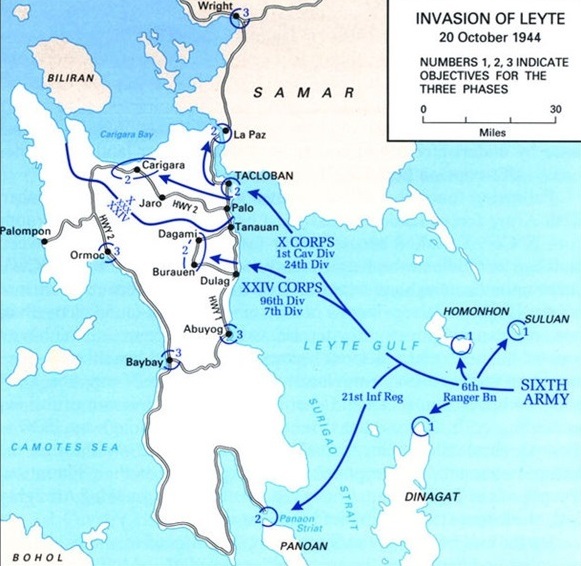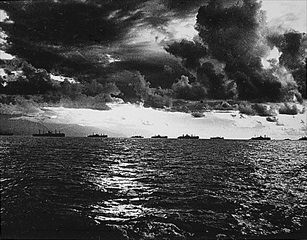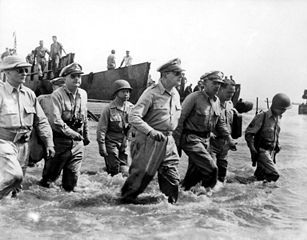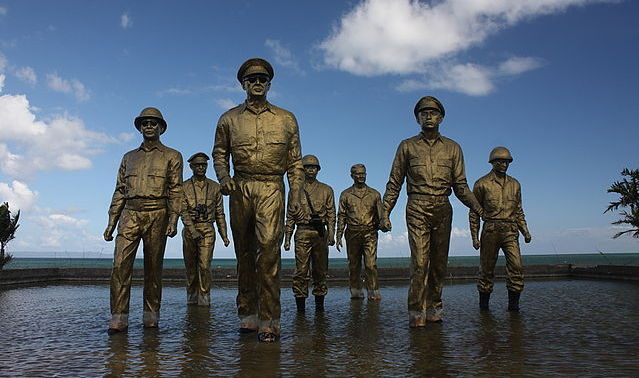MACARTHUR: “I HAVE RETURNED!”
Leyte Island, the Philippines • October 20, 1944
On the same day (Japanese time) the forces of Imperial Japan struck Pearl Harbor, Hawaii, in a surprise assault on U.S. military installations, they struck the American territory of the Philippines. On May 6, 1942, Japan swept the last American garrison from the archipelago by capturing Corregidor Island, which guarded the Philippine capital, Manila, now occupied by the Japanese. Controlling the Philippines was vital for Japan’s goal of becoming the geopolitical power broker in Southeast Asia. The Philippines commanded the main sea routes to the resource-rich islands of Borneo and the Dutch East Indies by which important industrial raw materials like rubber, tin, nickel, bauxite ore, coal, and unprocessed and refined crude oil (the latter mineral embargoed by the U.S., Great Britain, and the Netherlands in July and August 1941), as well as foodstuffs like tea, sugar, rice, and cacao, were shipped to the Home Islands. Borneo, divided between British and Dutch jurisdictions, fell to the Japanese when Allied troops stationed there surrendered in April 1942. Resistance in the Dutch East Indies (today’s Indonesia) collapsed a month earlier.
Japan also moved south and east to invade Australian-administered Eastern New Guinea (the western half of the island was part of Japanese-occupied Dutch East Indies). From late 1942 onward Australian and U.S. forces under four-star general Douglas MacArthur, Supreme Commander of the Southwest Pacific Area, campaigned to clear the enemy from the entire island. Months before the arduous New Guinea Campaign ended—and that only upon Japan’s unconditional surrender in August 1945—President Franklin D. Roosevelt and his military Joint Chiefs of Staff debated among themselves on the best approach from which to strike the Japanese homeland: capturing Formosa (Taiwan), the large island off the Chinese mainland, or retaking the Philippines. MacArthur, who had escaped the Philippines eight weeks before Corregidor fell, argued in favor of the Philippine route; so did most of the SWPA field commanders. Admiral Ernest J. King, Commander in Chief, United States Fleet and Chief of Naval Operations, argued in favor of Formosa, which was 500 miles/805 km closer to Japan. On September 9, 1944, it was settled: the less chancy Philippine route to the Japanese homeland was selected. The Joint Chiefs ordered MacArthur to occupy Leyte, a central Philippine island located on the eastern side of the archipelago, with a target date of December 20, a date which MacArthur himself had suggested but which was subsequently shifted forward by the same Joint Chiefs.
On this date, October 20, 1944, on a 25‑mile/40-km stretch of Leyte Island in the Philippines, an Allied attack fleet of 738 transport, escort, and landing vessels, supported by 18 aircraft carriers and 105 warships, put 160,000 U.S. troops ashore under the watchful eye of MacArthur aboard the cruiser USS Nashville. In the afternoon, the general, wearing his customary field marshal’s cap, crisply starched khakis, and sunglasses, waded ashore from a landing craft, approached a portable radio transmitter, and spoke into the microphone: “People of the Philippines: I have returned!”
Invasion of Leyte Island, October 1944, Phase One in Retaking the Philippines
 |
Above: Preliminary operations for the Leyte invasion (codenamed Operation King-Two) began at dawn on October 17, 1944, with mine-sweeping tasks and the movement of Lt. Gen. Walter Krueger’s U.S. Sixth Army toward 3 small islands in Leyte Gulf (right edge of map). At 10 a.m. on October 20, following 4 hours of ferocious naval bombardment by battleships and cruisers, Sixth Army forces landed on their assigned beaches, and within an hour they had secured most beachheads deep enough to receive heavy vehicles and supplies. By early afternoon the invasion beaches were secure enough for MacArthur to make his dramatic entrance through the surf onto Palo Beach (Red Beach) just south of the provincial capital of Tacloban.
 |  |
Left: The large American transport and escort fleet approaches Leyte Island at dawn on A‑Day, October 20, 1944. Within days the fleet and supply dumps ashore became the target of day and night enemy air raids, including those by bomb-laden kamikaze aircraft. The battle for Leyte (October 17 to December 26, 1944), one of the larger but certainly not most populous or economically important islands in the Philippine archipelago, cost the U.S. just over 3,500 killed and 12,000 wounded. Japanese dead were roughly 49,000. The air and naval Battle of Leyte Gulf—the largest naval clash of the war in terms of engagement area and tonnage of warships sunk—was fought off Leyte Island from October 23 to 26, 1944. The Japanese Navy suffered a decisive defeat. A tidal wave of panic swept through the imperial government as ministers were forced to contemplate the Philippines becoming a base for operations against the home islands.
![]()
Right: Making a dramatic entrance, MacArthur was captured in this iconic photograph by Gaetano Faillace, the general’s personal photographer during the war. MacArthur was accompanied by Philippine President-in-exile Sergio Osmeña (left in pith helmet) and Lt. Gen. Richard Sutherland, MacArthur’s chief of staff (to the general’s left) as the party splashed through knee-deep surf onto Red Beach, October 20, 1944. Once on shore MacArthur spoke into a microphone, reading his short (2 minutes) prepared text with great emotion: “People of the Philippines, I have returned! By the grace of Almighty God, our forces stand again on Philippine soil—soil consecrated in the blood of our 2 peoples. . . The hour of your redemption is here.”
 |
Above: MacArthur’s Landing by Anastacio Caedo (d. 1990) at MacArthur Landing Memorial National Park at Palo (Red) Beach overlooking Leyte Gulf. The double-life-sized bronze statues on a shallow manmade pool by one of the Philippines’ greatest sculptors was inaugurated during the 37th anniversary of A‑Day in 1981. The statues mark the spot where MacArthur fulfilled his 1942 promise of “I shall return” 2 years and 6 months after he was forced to flee the Philippines. The park is the site of the annual memorial rites and reenactment of the historic landing attended by local and foreign dignitaries together with war veterans and their families.
Contemporary Newsreel Account of MacArthur’s Landing on Leyte Island, Philippines, October 1944
![]()

 History buffs, there is good news! The Daily Chronicles of World War II is now available as an ebook for $4.99 on Amazon.com. Containing a year’s worth of dated entries from this website, the ebook brings the story of this tumultuous era to life in a compelling, authoritative, and succinct manner. Featuring inventive navigation aids, the ebook enables readers to instantly move forward or backward by month and date to different dated entries. Simple and elegant! Click
History buffs, there is good news! The Daily Chronicles of World War II is now available as an ebook for $4.99 on Amazon.com. Containing a year’s worth of dated entries from this website, the ebook brings the story of this tumultuous era to life in a compelling, authoritative, and succinct manner. Featuring inventive navigation aids, the ebook enables readers to instantly move forward or backward by month and date to different dated entries. Simple and elegant! Click 











